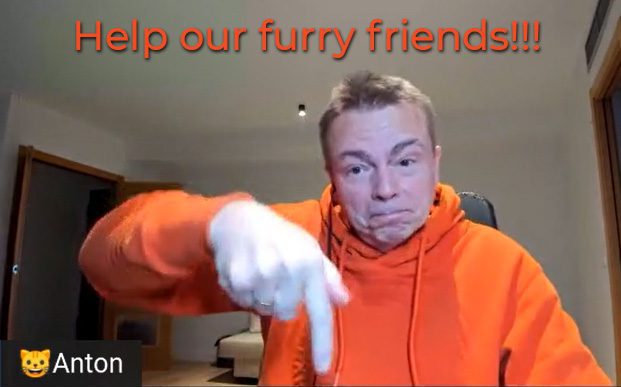I first became aware of Anton Shulke when he was Influencer Lead for Semrush. I really got to know him through his journaling of his exodus from Ukraine when the war broke out.
I became an enormous fan when he started raising money for dog and cat shelters in Ukraine. If you’d like to donate, look for a link in the transcription (they’re everywhere!).
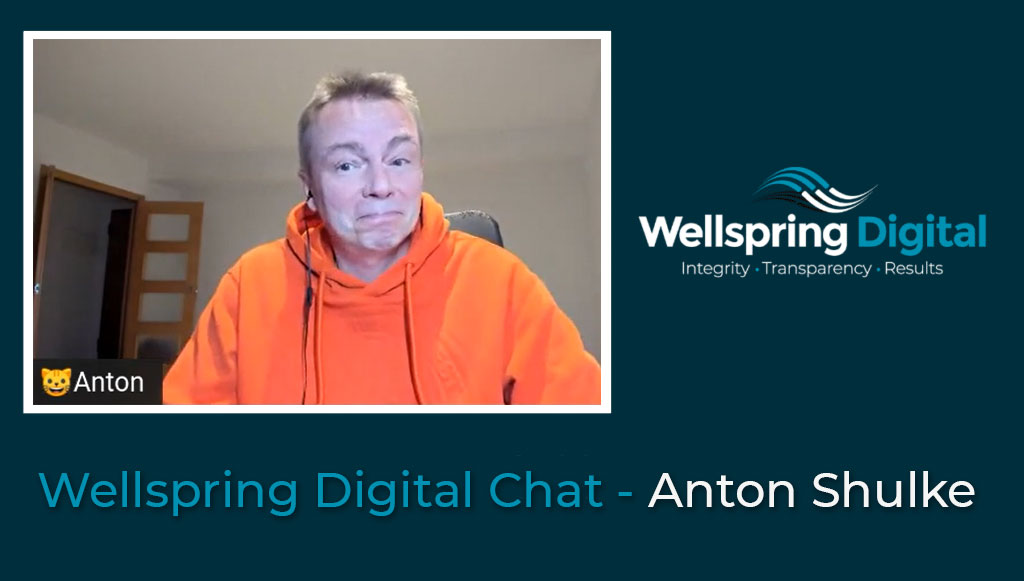
Anton is now the Head of Influencer Marketing at Duda, a professional website builder that is fast, secure, and easy to use. In this, Anton and I discuss the following…
- The advantages of live streaming for marketers
- Tips for hosting events with influencers
- Common misconceptions about influencer marketing
- Lesser known benefits of influencer marketing
- Website builders, CMSs, and the importance of Core Web Vitals
Enjoy!
Digital Transcription (Edited for Readability)
Introductions
Jon-Mikel Bailey: Hello, everyone, it is time for another episode of the Wellspring Digital Chat series. My name is Jon-Mikel Bailey, thank you for joining us. Today we have a friend of Wellspring. We are very excited to meet with him to get inside his marketing brain and pick out some really good nuggets of wisdom for all of you.
I first became aware of Anton when he was the influencer lead for Semrush. I feel like I really got to know him through his journaling of his experience getting the heck out of Ukraine when the war broke out.
But I became an enormous fan and I know a lot of other people did when he started raising money for dog and cat shelters in Ukraine and he still is doing that. And if you would like to donate, we will place the link in the show notes below the video. So down there.
Help animal shelters in Ukraine, DONATE TODAY!!!
So Anton, welcome, please take a moment to introduce yourself.
Anton Shulke: Thanks, Jon. Very, very nice to be here. Thank you for doing it. Okay, so my name is Anton Shulke. And I used to be a Semrush guy for five years. I left them about a year and a half ago and joined Duda.
I’m in Spain right now and I have plenty of Spanish-speaking SEO and non-SEO friends. And Duda in Spanish means doubt. And when I had just moved to Duda, everyone started asking me funny questions like “tienes alguna duda?” which means “Do you have any doubt?” or “Do you have any Duda?”.
I also have Polish friends, and Andrzej Duda is the President of Poland, which gives plenty of opportunities for jokes as well.
Duda is a CMS and a site builder. By the way, before joining them I thought that CMS and site builder are the same. And they are not. CMS is a database, and website builder goes on top and offers all the tools you use to create a website. For example, Duda is both, WordPress is both, but Elementor is a website builder that you can use with WordPress CMS.
Jon-Mikel Bailey: Got it. Yeah.
Anton Shulke: I didn’t know there was a difference.
Jon-Mikel Bailey: I think I knew that. I’m just gonna say that I knew that.
Anton Shulke: Yeah. Of course. So, I joined Duda to do influencer marketing as I did in Semrush. But before I could start working properly, I had to move out of Ukraine. So, we traveled from Kyiv to Poland and then eventually to Spain. It was kind of an epic journey for me.
Jon-Mikel Bailey: Yes, it was.
Anton Shulke: When the war broke out, so many people started texting me and asking how we were doing. It became very difficult to respond to each one of them individually, so I decided to start doing posts on Facebook.

And I started doing coffee shots (see above) every day to show that I was still alive and kicking. My photos reflected my journey through Ukraine and when we crossed the Polish border, I took a picture with a Polish flag. It took our family a month and a half to get out of Ukraine.
Jon-Mikel Bailey: Yeah, it was definitely very interesting to watch your journey. And I must say that every single cup of coffee looked completely and absolutely delicious and it made me want to you know, go get a coffee. But today we’re gonna talk live streams, we’re going to talk about CMSs, and influencer marketing. So, are you ready to jump in?
Anton Shulke: Sure.
Jon-Mikel Bailey: Let’s do it.
The Advantages of Live Streaming for Marketers
Jon-Mikel Bailey: You’ve been doing live stream events since 2015 which is quite a long time. Can you tell us why you liked this format and how it could be advantageous for other marketers to try?
Anton Shulke: I started doing live streams when I worked for a small Ukrainian company because doing them was easy and cheap. I used Hangouts as a streaming software and YouTube as a platform. Today streaming is even easier. New software such as Streamyard is available, and we can create small introduction videos to enhance the watching experience.
Originally, I didn’t know anything. I just was doing streams because I could. But after a certain point, I started thinking, why I’m doing it? And this is the question that every marketer who aspires to start doing streams must answer to themselves – why do you do it?
I know it may sound ridiculous like one of those philosophical questions people sometimes ask without really expecting an answer. But in this case, it’s a very practical question because companies do live streams for very different purposes.
In my case, we at Duda are doing live streams as an influencer marketing exercise. It may sound weird to some marketers because typically they run such events for lead generation or boosting sales. In our case, lead generation is one of the objectives, but definitely not the primary one.
So, for us, live streams are primarily an influencer marketing tool. And it brings tons of value.
Let’s discuss how influencer marketing works. Ideally, you would like to sit and have a coffee with an influencer to bring them to your side and turn them into your brand advocate. It’s the best-case scenario. But unless you have unlimited resources, the effectiveness of this approach is questionable. And for a couple of years during the COVID pandemic, it was just impossible. But you can communicate with influencers online, and if you are doing it right, it’s the same level of interaction as face-to-face conversation.
Emails or telephone calls are nowhere near live video conversations in terms of effectiveness. You cannot become friends with someone without seeing their face. At the same time, preparing and running even a short live streaming event together creates a bond with your co-host – and you even may eventually become friends.
I’d even go as far as saying that the result of my live streams is often not as much important to me as the process of creating them and interacting with people who help me run them.
Tips for Hosting Events with Influencers
Jon-Mikel Bailey: You’ve organized all sorts of events with leading influencers in SEO and other marketing influencers. Do you have any advice for marketers looking to put on an event with an influencer? You mentioned you have to answer the question why, but what else? What other things should they be thinking about?
Anton Shulke: This is the most important piece of advice. Only do things with people who want to do things with you and who are genuinely interested. It happened to me so many times. Imagine a person who, for whatever reason, agrees to run an event with you. This person is undoubtedly very knowledgeable and has a great personality. But the moment the stream starts, you both (and the audience!) immediately feel that this person just doesn’t belong there.
Maybe they agreed to take part in your event only out of politeness. Maybe you asked them too many times and forced them to do it. Maybe you just haven’t found the right angle to discuss the topic. In any case, such an event won’t benefit either of you.
I prefer to work with people who really see the value, enthusiastic people. When I try to bring big names to my streams, I’m not being persistent, I’m giving them reasons to get excited about this opportunity.
Jon-Mikel Bailey: That’s great advice. That would vastly improve your engagement with that person, the back and forth, and the quality of the conversation itself. Plus, you know, it seems to me that an unmotivated influencer isn’t very influential.
Anton Shulke: Another important piece of advice. There are plenty of influencers with a very limited range of topics. When you ask them what they would like to talk about, they give you a link to five old presentations that they’ve been giving for years at different conferences. This is a clear sign of a lack of interest from their side.
Even when dealing with the biggest names in the industry, I always ask them to add something unique for my events – not necessarily a totally new slide deck from scratch, but at least something.
Common Misconceptions about Influencer Marketing
Jon-Mikel Bailey: Could share with us some of the more common misconceptions that people might have about influencer marketing? What it is and isn’t, that sort of thing.
Anton Shulke: Before we start talking about misconceptions, it’s important to discuss influencer marketing concepts. Nowadays, everyone and their dog are developing influencer marketing platforms. That’s an interesting trend, there have not been many such tools in the past.
And after talking to developers, I realized that today, there are two major approaches to influencer marketing. They are as different as PPC and SEO.
The PPC-like approach is the mainstream one. It is very popular, especially on Instagram. You find an influencer with a certain audience size who creates relevant content, you pay them, and you get results immediately. This is how most marketers perceive influencer marketing today.
But there is another approach, and I’ve always been its evangelist. This concept has a lot in common with SEO because it does not provide immediate returns. It takes longer to get results, but its effect also stays much longer. I wouldn’t say it’s much cheaper than the PPC-like approach because it demands time investment and effort.
The main goal of an SEO-like approach is to build long-lasting relationships with people who love your brand – and not waste your time on those who hate it.
Of course, being friends with influencers does not mean you will never have to pay them money. But even when money is involved, we are not buying influencers’ loyalty. It’s not like a trade. And, for example, we never pay for webinars. All my co-hosts do them for free.
Jon-Mikel Bailey: Which goes back to your point about them wanting to do it?
Anton Shulke: Yes, but apart from the good relations and interest in doing it, they get exposure and access to new audiences, and we help them in other ways.
Talking about misconceptions, many of those appear when people mix up the two concepts we discussed earlier. Also, many marketers for some reason think that influencers and their audiences are interested in what companies are doing.
So, for example, they want influencers to share news about new features in their product. But it does not work this way. You must offer something interesting to influencers if you want them to genuinely support your case.
Jon-Mikel Bailey: Yeah, that makes perfect sense to me. It seems that many people go into influencer marketing with the wrong sort of motivation or idea of what its value is. And I think one of the more common misconceptions is that you know, influencers, unless you pay them a bunch of money, won’t do anything. And sometimes I think you can get…
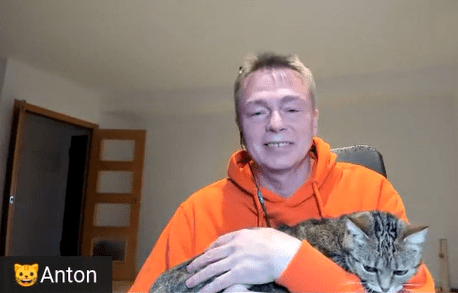
There’s one of those, there’s that cat!
And sometimes I think you can get more out of them if they’re really motivated.
Lesser Known Benefits of Influencer Marketing
Jon-Mikel Bailey: Staying with influencer marketing, you don’t see a lot of smaller or even medium-sized businesses engaging this, especially in the B2B world. What are some benefits that they might be missing in terms of influencer marketing if they are not engaging in an influencer marketing campaign?
Anton Shulke: For me, it’s very difficult to answer this question because I can’t understand why some companies don’t see the benefit of using influencers. Of course, if you’re a very small or a local business, you probably don’t need Lady Gaga to promote you. But influencers are everywhere.
You are an influencer, I am an influencer, and even my cat is an influencer. Small and local influencers in some cases are much better for a business. Your company could do offline activities with local leaders, local churches, or anyone you can imagine.
For any business type and size, there are influencers out there that can provide enormous value and a very long-lasting effect. Influencer marketing is an excellent tool, and I cannot imagine why a business wouldn’t use it.
Jon-Mikel Bailey: This might come as a surprise to some of the people who watch these videos, but that’s kind of what we’re doing right now. I have someone who wants to be here and who wants to talk about what they know. And there’s definitely a long tail of value to the content that we’re producing and what we’re putting up there.
So, I agree with you, I don’t understand how people can’t see the benefits, but some people just maybe have blinders on.
Anton Shulke: And sometimes this long-lasting effect may really be surprising. While running Semrush webinars, I oftentimes invited experts who were not very well-known in the industry. But you never know where this person will be in a couple of years. Maybe they will grow famous. And they will remain your friend and your brand ambassador because you helped them launch their career with your webinar.
Jon-Mikel Bailey: I think it all comes down to the quality of the content too. I mean, if that person is a source of great content in your industry, but maybe they’re not famous, who cares, get that content and get insights.
Website Builders, CMSs, and the Importance of Core Web Vitals
Jon-Mikel Bailey: So, bringing you on here, I wanted to talk about influencer marketing. But I definitely want to give you a chance to talk a little bit about Duda. And I want to ask you, what do you see as the future of website builders and CMS in general? WordPress has been top of the heap for quite a while, is this going to change? Are we going to see a changing of the guard?
Anton Shulke: I doubt an immediate change in the market is possible. WordPress’ share is about 40%. There is hardly a way Duda or any other company can easily overturn it. The situation is similar to Google and the rest. It’s very difficult to push away someone who already has such an advantage.
Besides, WordPress is a fantastic CMS and site builder, especially for bloggers. If you need to create one website, and you have WordPress skills, don’t look anywhere else, you’ve got it covered.
Duda caters to other audiences, for instance, agencies. Let’s say you are an agency and you have five new clients each of those needing a website. And you already have 100 clients. With Duda, you can create websites faster, spend less money on development, and get automatic updates for your websites. That last point is very important. WordPress websites need constant maintenance which can end up in spending hundreds of work hours updating plugins, applying security patches, etc. Duda offers better scalability and automatization that can save agencies loads of time and money.
Jon-Mikel Bailey: And what about a website for a company that has multiple divisions or multiple entities? Do you think it makes sense for them to look at some solution other than WordPress if they have a lot of microsites or different site versions?
Anton Shulke: The only reason web designers often choose WordPress is that they are used to it. And they can spend more hours building a WordPress website meaning that they will get paid more if they get paid per work hour. Switching to another platform such as SquareSpace, Wix, or Duda, may make much sense in terms of effectiveness. It becomes clear when C-level or business owners do the math, but such decisions are often made by developers who are not willing to change anything. And again, in some cases, WordPress is still the best choice.
Jon-Mikel Bailey: I appreciate you saying that. Because you know, you could easily come on here and say no, Duda is the best and everybody should use it.
Anton Shulke: Duda is the best when it comes to Core Web Vitals. You can see it in the monthly reports created in Google Data Studio. They check Core Web Vitals of the most high-traffic websites for almost every CMS. Duda is the number one with a big advantage because they did put so much effort into it. Other CMS developers such as Wix are pushing hard trying to get there, but today Duda is the fastest solution.
Jon-Mikel Bailey: I don’t think many people really understand. Especially if you’re using some sort of WordPress theme with a lot of plugins. They all have to load even if you’re not using them. I don’t think people really realize how slow a WordPress site can become. It’s not hard to do.
Anton Shulke: Exactly. A very seasoned WordPress developer knows how to deal with it and make a fast website. But, looking at the Core Web Vitals report I mentioned above, you can see that WordPress scores are very low. WordPress is extremely popular, and many people who use it don’t really know what they are doing. As a result, they create very slow websites.
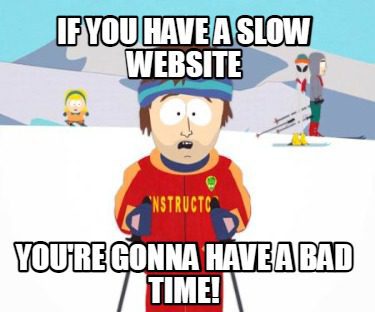
Jon-Mikel Bailey: You cannot underestimate the importance of speed for a website. It’s critical for user experience, and it’s critical for SEO. There wouldn’t be Core Web Vitals if Google didn’t care about speed.
Anton Shulke: Core Web Vitals cover more aspects than mere speed, but fast loading times are extremely important.
Jon-Mikel Bailey: Speed and usability. Yeah, exactly. So well, Anton, I really appreciate your time today on this. I also want to encourage people to go and donate to your animal shelters support project.
Anton Shulke: I call them shelters but usually those are just some enthusiastic people who cannot pass by when they see a stray animal, so they pick them up and bring them to their homes. Some of them have over 150 animals. Before the war, they were supported by Ukrainians such as myself who made small donations. Now, when we are at war, people often don’t have enough money even to feed their families, so the number of donations dropped dramatically. What makes it worse, since millions of Ukrainians had to flee their homes, the number of abandoned animals has spiked. It is not always possible to take your pet with you when you run from war.
The people who help those animals survive don’t get any state support. So, I’m trying to help them using the “Buy Me a Coffee” website. You can click this link and donate as little as $5 (or more if you want). For us, who live in Western countries, $5 is next to nothing. To a cat or a dog in Ukraine, it means the difference between life and death.
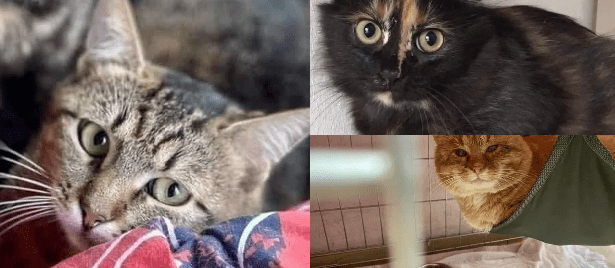
Jon-Mikel Bailey: Thank you for doing that work. Because that’s something that often gets forgotten in a situation like this. So, yes, make sure to make as much noise about that as possible and get as much money to those people as possible. And for those pets. Let’s get some money for some pets, people.
Anton Shulke: Thanks for having me.
Jon-Mikel Bailey: Thank you!
